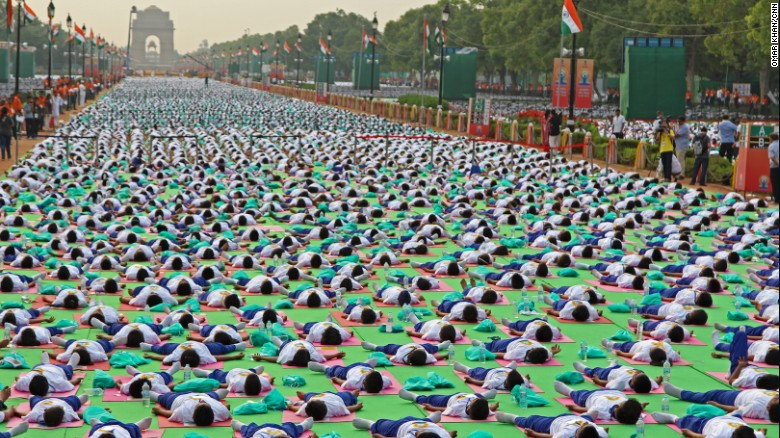
Hong Kong – The Sanskrit word “yoga” may mean union but, for some in India, yoga has never been more divisive.
June 21 marks the first ever International Day of Yoga, an event that’s driven by Indian Prime Minister Narendra Modi. A faithful yoga practitioner for years, Modi persuaded the United Nations last year to devote a day to the ancient discipline.
This Sunday, around 45,000 people in New Delhi attempted to break the world record for the single largest session of yoga.
Modi was present at the public demonstration which included civil servants and students, many of whom were ordered to practice their chaturangas and downward dogs ahead of the event.
Similar yoga events are being held all around the globe.
Modi’s worldwide yoga vision, however, isn’t sitting well with everyone. Some in India’s Muslim community, which makes up around 15% of the population, say they are feeling marginalized.
Religious associations
Although it’s viewed mainly as a form of physical exercise in the west, yoga carries religious associations in India.
Muslim associations like the influential Islamic scholars group, Jamiat Ulema I Hind, the All India Muslim Personal Law Board and several prominent imams have taken issue with a common sequence called “sun salutations” which they interpret as sun worship.
“Om” which is often chanted in yoga classes is also a sacred sound in Dharmic religions.
“We do not know how it has been approved by the UN,” Abdul Rahim Qureshi, an All India Muslim Personal Law Board spokesperson told CNN.
“A true Muslim cannot take part in yoga. The yoga is made compulsory for the primary and high school students. What are they teaching little children? The government should not take up this cause of yoga and impose them on non-Hindus.”
To ease the backlash, Indian authorities reassured the public that sun salutations would be dropped from the event, though chanting “om” would still be a part of it.
Government officials also pointed out that out of 177 sponsoring nations, 47 are from the Organization of Islamic Countries.
Who owns yoga?
Objections from India’s Muslim community are not the only point of strain. Although yoga’s roots are undeniably Indian, much of what is practiced today is an Americanized version.
There are over 25 million people who practice yoga in the United States alone, by far the largest single market, and that’s grown 33% since 2009, according to a study from the Sports and Fitness Industry Association.
It’s a multi-billion dollar market that extends to $420 yoga leggings and $140 mats.
The vigorous push from the Indian government has given new life to a debate over who owns yoga and what defines it.
Newly-appointed Indian minister for yoga Shripad Yesso Naik said it’s something India wants to reclaim from the west.
“We’re trying to establish to the world that it’s ours,” Naid told the Washington Post.
Noah Maze, a LA-based yoga teacher however believes the yoga practiced today is something new.
“While it has roots in practices from India, and certainly we can find lists of asanas in some of the medieval alchemical texts of hatha yoga, what is practiced today really is an innovation and evolution of what was practiced traditionally,” Maze said.
“I would expect that Indian yogis may be looking at yoga’s explosion internationally, and feeling a sense of ownership and entitlement to the practices and concepts,” Maze added.
Yoga booty ballet anyone?
Striking the right balance between respecting the tradition’s roots and its new incarnations as yoga’s popularity surges is a question many practitioners grapple with.
“I quiver a bit when hearing of the lax usage of the word ‘yoga’ these days,” said Tim Feldmann, an Ashtanga teacher who co-founded the Miami Life Center with his yogi wife Kino Macgregor.
“A yoga studio down the road from us here in Miami offers ‘yoga booty ballet’. In my ear, that is obviously an only commercial aspirational use of the word.”
For Macgregor, it’s a mindset much more than the ability to twist like a pretzel and she emphasizes it’s open to anyone.
“This brilliance does not belong to any one culture,” she said.
As reported by CNN
